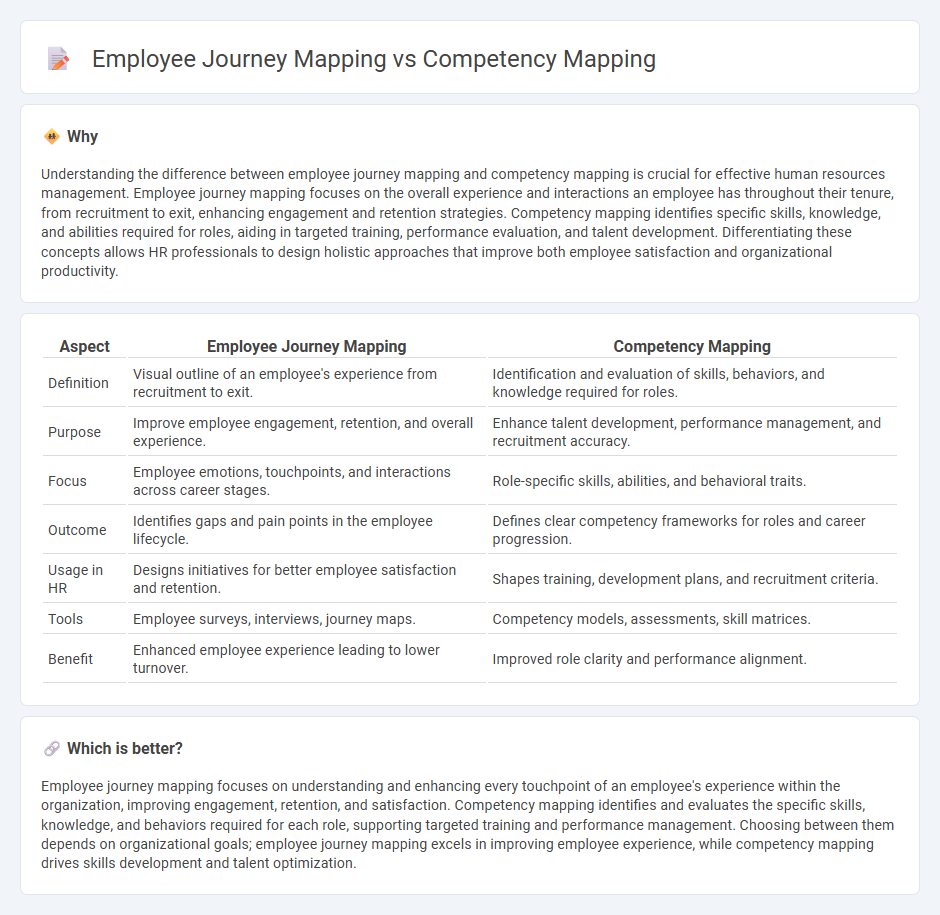
Employee journey mapping visualizes the entire experience an individual has within an organization, from recruitment to exit, focusing on touchpoints that impact engagement and satisfaction. Competency mapping identifies the skills, behaviors, and attributes required for specific roles to ensure alignment with organizational goals and performance standards. Explore more about how these HR tools enhance talent management and organizational effectiveness.
Why it is important
Understanding the difference between employee journey mapping and competency mapping is crucial for effective human resources management. Employee journey mapping focuses on the overall experience and interactions an employee has throughout their tenure, from recruitment to exit, enhancing engagement and retention strategies. Competency mapping identifies specific skills, knowledge, and abilities required for roles, aiding in targeted training, performance evaluation, and talent development. Differentiating these concepts allows HR professionals to design holistic approaches that improve both employee satisfaction and organizational productivity.
Comparison Table
| Aspect | Employee Journey Mapping | Competency Mapping |
|---|---|---|
| Definition | Visual outline of an employee's experience from recruitment to exit. | Identification and evaluation of skills, behaviors, and knowledge required for roles. |
| Purpose | Improve employee engagement, retention, and overall experience. | Enhance talent development, performance management, and recruitment accuracy. |
| Focus | Employee emotions, touchpoints, and interactions across career stages. | Role-specific skills, abilities, and behavioral traits. |
| Outcome | Identifies gaps and pain points in the employee lifecycle. | Defines clear competency frameworks for roles and career progression. |
| Usage in HR | Designs initiatives for better employee satisfaction and retention. | Shapes training, development plans, and recruitment criteria. |
| Tools | Employee surveys, interviews, journey maps. | Competency models, assessments, skill matrices. |
| Benefit | Enhanced employee experience leading to lower turnover. | Improved role clarity and performance alignment. |
Which is better?
Employee journey mapping focuses on understanding and enhancing every touchpoint of an employee's experience within the organization, improving engagement, retention, and satisfaction. Competency mapping identifies and evaluates the specific skills, knowledge, and behaviors required for each role, supporting targeted training and performance management. Choosing between them depends on organizational goals; employee journey mapping excels in improving employee experience, while competency mapping drives skills development and talent optimization.
Connection
Employee journey mapping and competency mapping are interconnected by aligning the stages of an employee's experience with the specific skills and competencies required at each phase to enhance performance and engagement. Competency mapping identifies critical abilities needed for roles, while employee journey mapping visualizes the touchpoints where these competencies are developed or applied. This integration supports targeted training, performance management, and talent development strategies within human resources.
Key Terms
**Competency Mapping:**
Competency mapping systematically identifies the skills, knowledge, and behaviors required for effective job performance, aligning individual capabilities with organizational goals. It involves detailed assessments to create a framework that guides recruitment, training, and career development, ensuring employees meet evolving business needs. Explore how competency mapping drives talent optimization and organizational success.
Skill Assessment
Competency mapping identifies specific skills and behaviors required for effective job performance, providing a clear framework for skill assessment and development within an organization. Employee journey mapping captures the employee's experience and touchpoints throughout their career, helping to identify skill gaps and learning opportunities at each stage. Explore more on how these methodologies complement skill assessment strategies for enhanced workforce development.
Role Requirements
Competency mapping identifies the specific skills, knowledge, and behaviors required for effective role performance, making it essential for recruitment, training, and performance evaluation. Employee journey mapping focuses on the entire experience of employees within an organization, highlighting key touchpoints from onboarding to role transitions but emphasizes emotional and experiential aspects rather than detailed role requirements. Explore how integrating competency mapping with employee journey mapping enhances talent management strategies.
Source and External Links
What is competency mapping and how can organisations implement ... - Competency mapping is the process of identifying and mapping the skills, competencies, and personal attributes required for specific roles, using behavioral indicators and proficiency levels to match employees with suitable positions and create clear competency matrices for organizational standards.
Mastering the Competency Mapping Process - Competency mapping involves identifying and assessing the key skills, knowledge, and behaviors needed for success in each role, categorized as core, functional, and leadership competencies, to align workforce capabilities with business goals and improve hiring, training, and succession planning.
What Is Competency Mapping? (Plus Benefits and Steps) - Competency mapping determines the skills, behaviors, abilities, and knowledge each job requires, establishes metrics for assessment, and highlights where additional training or resources may be needed to support employee and organizational growth.
 dowidth.com
dowidth.com